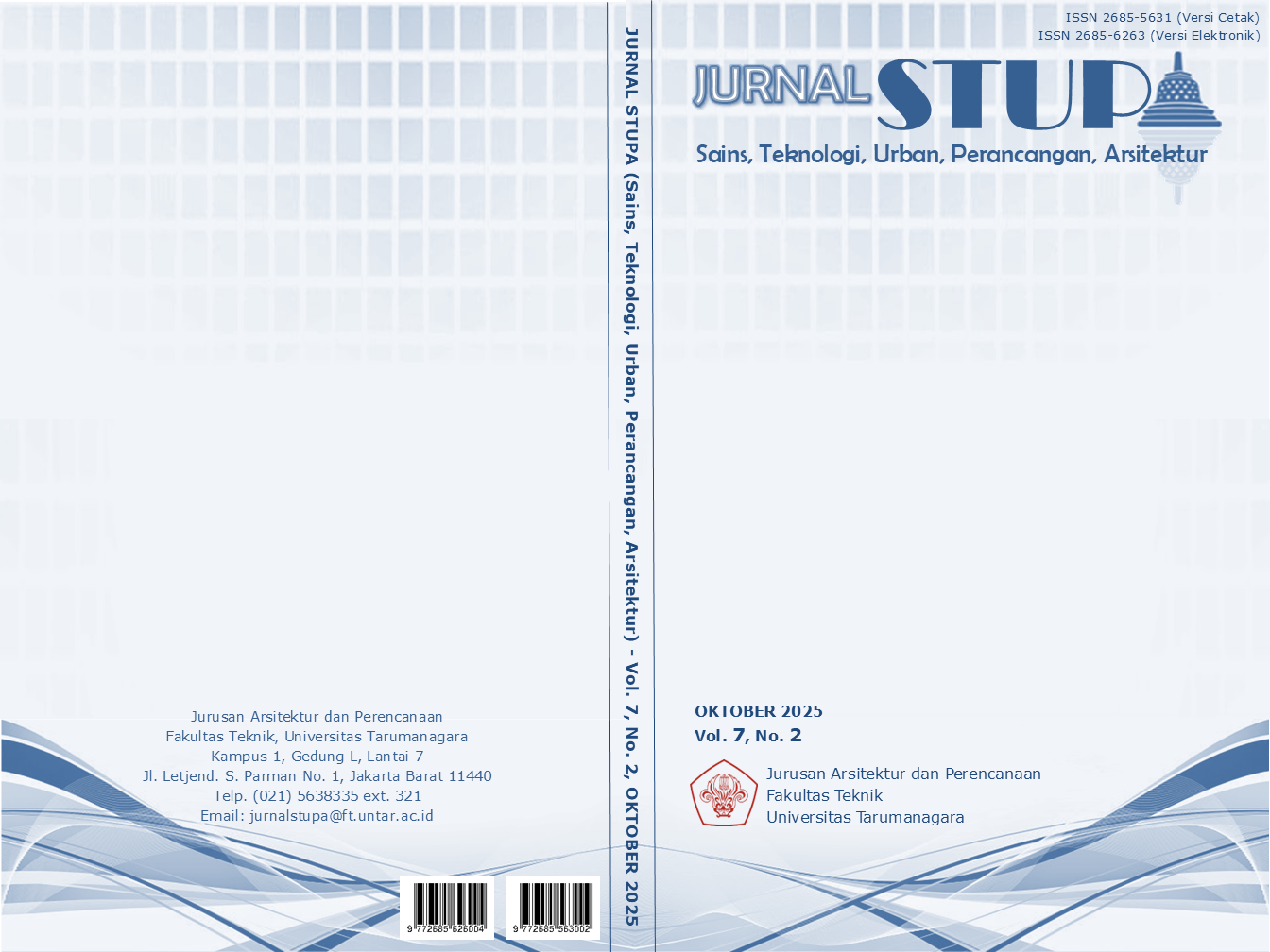WATER – ENERGY NEXUS: ARSITEKTUR SISTEM PENGELOLAAN AIR DAN ENERGI ALTERNATIF DI KAMPUNG TELUK GONG – JAKARTA UTARA
Main Article Content
Abstract
Kampung Teluk Gong in North Jakarta is currently facing a critical shortage of clean water due to waste pollution and inadequate sanitation infrastructure. This paper presents a regenerative architectural solution through the Water–Energy Nexus approach, which integrates rainwater and floodwater treatment systems into clean water sources while utilizing them as an alternative energy supply. The study is focused on a micro-site scale using a community-based design approach, without exploring broader aspects such as policy, macroeconomic considerations, or city-wide utility systems. The scope is limited to: (1) social and site analysis in Kampung Teluk Gong; (2) the application of simple technologies such as water filtration and structure-based micro-hydro systems; and (3) spatial programming that responds to local climate and community habits. The “Oasis of Peace” project serves as a conceptual reference for sustainable water systems, but only as a programmatic inspiration. The design centers on a multifunctional building with three primary zones: sustainable housing, clean water distribution, and social-educational spaces. The findings indicate that a modular stepwell design can contextually address basic water and energy needs. This paper does not include technical simulations or numerical efficiency calculations, thus offering opportunities for future research on structural and technological aspects.
Keywords: architecture; clean water; regenerative; residential; village
Abstrak
Kampung Teluk Gong di Jakarta Utara saat ini menghadapi masalah ketersediaan air bersih akibat pencemaran limbah dan kurangnya infrastruktur sanitasi. Tulisan ini menguraikan solusi arsitektur regeneratif dengan pendekatan Water–Energy Nexus, yang mencakup penggabungan sistem pengolahan air hujan dan banjir menjadi air bersih serta pemanfaatannya sebagai sumber energi alternatif. Penelitian ini berfokus pada skala tapak mikro dengan pendekatan desain yang berbasis komunitas, tanpa mengkaji aspek kebijakan, ekonomi makro, atau sistem utilitas kota secara umum. Pembahasan terbatas pada: (1) analisis sosial dan lokasi di Kampung Teluk Gong; (2) penggunaan teknologi sederhana seperti filtrasi air dan mikrohidro berbasis struktur; serta (3) pengembangan program ruang yang responsif terhadap iklim dan kebiasaan masyarakat. Studi kasus "Oasis of Peace" dijadikan acuan untuk konsep sistem air berkelanjutan, tetapi hanya sebagai sumber inspirasi untuk program. Desain berfokus pada gedung serbaguna dengan tiga area utama: hunian berkelanjutan, penyediaan air bersih, dan tempat sosial untuk pendidikan. Temuan menunjukkan bahwa rancangan stepwell dapat memenuhi kebutuhan mendasar akan air dan energi masyarakat secara kontekstual. Jurnal ini tidak menyertakan simulasi teknis sistem air atau perhitungan efisiensi energi secara numerik, sehingga memberikan peluang penelitian lebih lanjut pada aspek struktural dan teknologi di masa yang akan datang.
Article Details

This work is licensed under a Creative Commons Attribution-NonCommercial-ShareAlike 4.0 International License.
This work is licensed under a Jurnal Sains, Teknologi, Urban, Perancangan, Arsitektur/ STUPA Creative Commons Attribution-NonCommercial-ShareAlike 4.0 International LicenseReferences
Amelia, N. S., Putri, I., Wardoyo, A., Lestari, O. D., Sari, Y., Maulida, D., . . . Wahyu, A. (2024). Upaya Konservasi Air melalui Sosialisasi Edukasi Penggunaan Air Efisien di Lingkungan Masyarakat Gg. Citra, Krajan Timur, Sumbersari. URNAL PENGABDIAN MASYARAKAT BANGSA, 4364 - 4368.
Armstrong, R. (2023). Introducing Regenerative Architecture. Journal of Chinese Architecture andurbanism, 2-10.
Erwanto, Z., Ilmi, M., & Hisamadi, M. R. (2021). Penerapan Teknologi Menara Penangkap Kabut (Fog Harvesting) Untuk Kebutuhan Air Bersih. JURNAL PENGABDIAN MASYARAKAT, 33-37.
Fakhriyah, Yeyendra, & Marianti, A. (2021). Integrasi Smart Water Management Berbasis Kearifan Lokal Sebagai Upaya Konservasi Sumber Daya Air di Indonesia. Indonesian Journal of Conservation, 34 - 41.
Gionita, P. F., Nurhidayt, E., & Herawati, H. (2024). PENYEDIAAN AIR BERSIH MELALUI PEMANENAN AIR HUJAN DI PERMUKIMAN TEPIAN SUNGAI KAPUAS. Jurnal Ilmiah Arsitektur, 194-199.
Hidayah, N. (2024). Krisis Air Bersih di Indonesia. Researchgate, 4-8.
Khare, S., & Varade, D. M. (2022). Design and Analysis of Micro Hydro Power Generation System for Community Water Supply. Renewable Energy Journal, 112–120.
M. , A., Rahman, Ahmed, & M.A, Z. (2022). Exploring Water–Energy Nexus for Sustainable Infrastructure: A Review of Emerging Technologies. Journal of Environmental Management, 302, 114–122.
Macaione, I., Raffa, a., & Andaloro, B. (2024). Climate-Adaptive Nature-Based Regenerative Urban Green Streetscapes: Design Exploration from the City of Matera. Sustainability, 2 - 29.
Pawlyn, M. (2022). Arup Explores: Regenerative Design. ARUP, 5-71.
Sembiring, F. Y., & Wijaya, J. K. (2025). Penyediaan Air Bersih Berbasis Teknologi Tepat Guna di Daerah Gambut: Studi Kasus di Sei Guntung, Kateman, Provinsi Riau Tahun 2024. Jurnal Abdi Masyarakat Indonesia, 119 - 124.
Utari, V., Yuwono, B. E., & Prasetyo, R. F. (2021). PENERAPAN KONSERVASI AIR PADA GEDUNG CUNIVERSITAS TRISAKTI SEBAGAI UPAYA MENUJU GREEN BUILDING. Seminar Intelektual Muda, 440 - 445.



